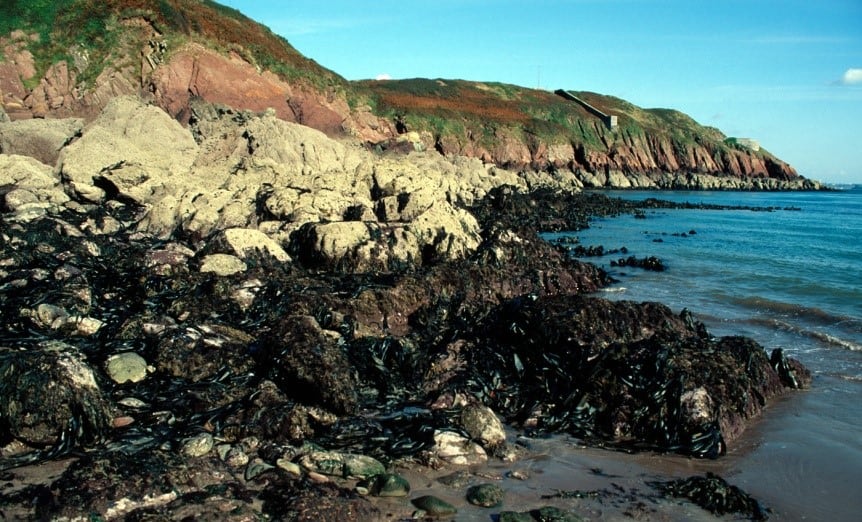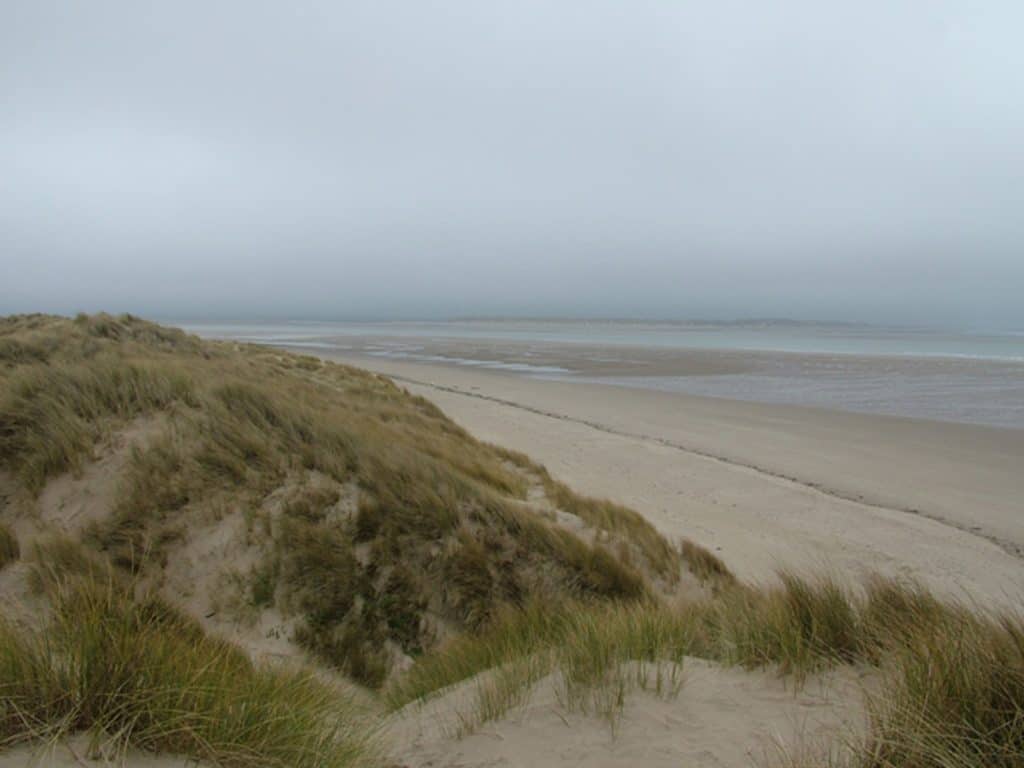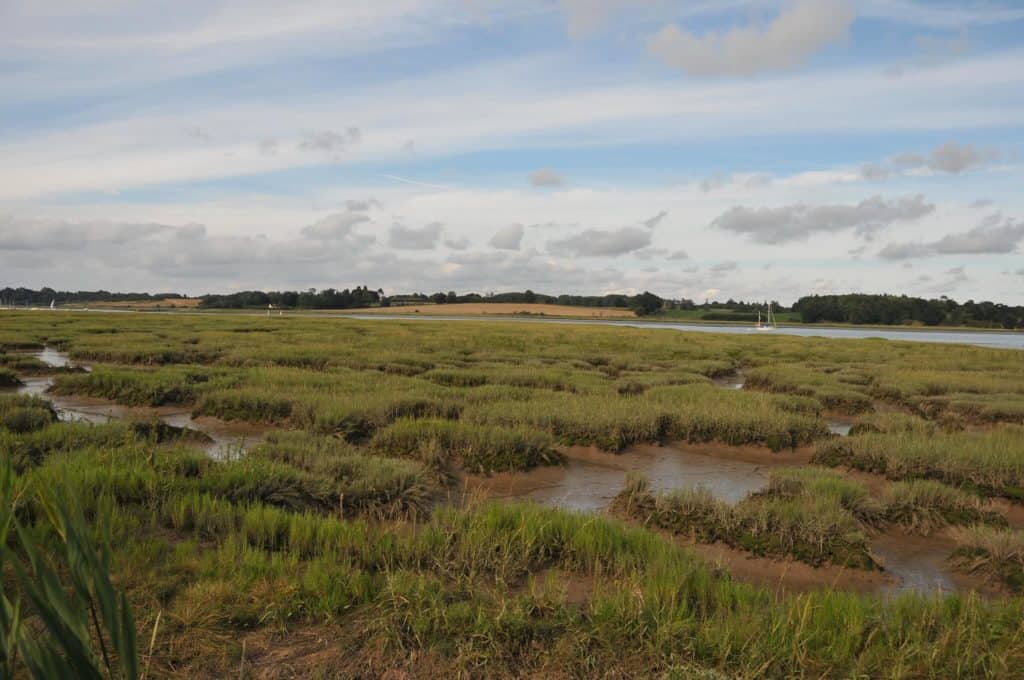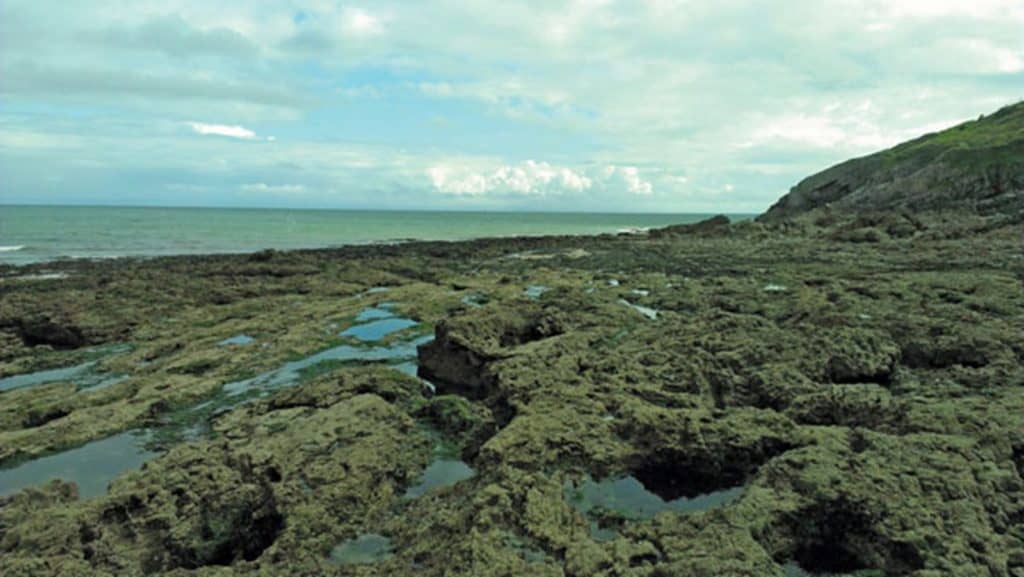What is diversity?
Ecological diversity (or biodiversity) is the total amount of variety within life on earth.
Both species diversity and genetic diversity are important within a habitat, because they make it more likely that the habitat can adapt successfully to changing conditions.
Diversity in marine habitats
Diversity studies can be carried out at a number of different marine habitats including:
- Rocky shores: the area between high and low water with is predominantly formed of solid rock
- Salt marsh: an extremely sheltered muddy ecosystem dominated by organisms tolerant to saline conditions
- Sand dunes: accumulations of sand stabilised by vegetation
What questions do biologists ask?
You can ask many scientific questions about contrasting areas within a similar habitat. Here are some examples.

- Describe how you would measure the diversity of invertebrates on this rocky shore
- How does the diversity of invertebrates vary between different parts of the rocky shore?
- Is this variation in diversity related to height above sea level?

- How does vegetation diversity change with distance from the sea shore?
- Do the oldest dunes have the highest diversity?
- Sand dunes used to be managed by stabilising bare sand wherever possible. Why is this no longer done?

- Why does plant diversity vary between different parts of this saltmarsh?
- Who might be interested in the plant diversity of this saltmarsh?
- How should this saltmarsh best be managed?
What questions could you investigate with fieldwork?
Here are some examples. Each research question has been split into 2 or 3 sub-questions.
| Research question | Sub questions |
|---|---|
| Investigation into the effect of height up the shore on the biodiversity of marine gastropods | How does gastropod diversity (species composition and abundance) differ with height up the shore? What abiotic differences are there? |
| Investigation into the effect of age of sand dune on the biodiversity of plant community | How does plant diversity (species composition and abundance) differ with age in the sand dune system? What abiotic differences are there? |
|
What level of grazing produces the highest grassland diversity in a saltmarsh? | Compare diversity in 3 areas of grassland with a different grazing regime, plus a control. Why do these variations occur? What abiotic differences are there? |
Synoptic links
A good investigation will make links between different parts of the A-Level Biology specification. Here are some possible synoptic links for investigations into freshwater habitats.
| Synoptic link | Detail |
|---|---|
| Succession | Grazing, trampling and tree clearance produce a deflected climax. Abandonment will lead to secondary sucession. |
|
Sustainability | Food production. Conservation. |
| Photosynthesis | Sunlight changes in different areas of vegetation height. |
| Conservation | Appropriateness of different management regimes. |
Before you start
On a rocky shores and salt marshes, height above low tide is more important than horizontal distance. Use tide tables to identify the time of low tide, then use this as a reference point. You can also use the tide tables to work out how much higher your reference point is from extreme low water spring tide (ELWS) level.
Height levelling with an optical level needs two people. The first person stands at the water’s edge with an optical level placed so that the eye piece is level with the top of a metre rule. This first person asks a second person to move up the rocky shore/salt marsh until the point that the bottom of the second person’s feet become visible through the eye piece. The rise from the two people is therefore 1 metre. Repeat the procedure to continue measuring the height.
Use a tape measure to record the ground distance between the two heights. Using trigonometry, you can calculate the actual horizontal distance from these results.
What is this habitat like?
A rocky shore is the area between high and low water which is predominantly formed of solid rock. Rocky shores pack a lot of habitat diversity into a small space.

A rocky shore can be divided into four zones, which run parallel to the sea. The characteristics of these zones is determined by the tides. The lower shore is covered in seawater for most of the day, while the top of the upper shore is exposed to the air for all but a few hours a year.
- The zone above the highest tides. It is splashed by spray but not covered by the sea. It is not really terrestrial nor truly marine.
- The top of this zone gets covered by the sea for <1% of the year. The bottom of it for about 20% of the year.
- The top gets covered for about 20% of the year. The bottom for about 80% of the year.
- The top of this zone gets covered for about 80% of the year. The bottom for <1% of the year.
At high tide, all parts of the rocky shore except the splash zone are covered in seawater. This is called immersion. At low tide, as the water drops, the shore is exposed to drying (called emersion, the opposite of immersion).
Abiotic factors on rocky shores
Emersion becomes less the further down the shore you are. On neap tides it may be that days occur when the lower shore never dries out. Likewise, on neaps the upper shore may never get water on some days. What abiotic factors are driven by the tides?a
Dessication
Dessication means drying out. It occurs as a result of emersion at low tide. Dessication influences the upper and middle shore.The basic physiology of most marine organisms is very simple: the co ncentration of their internal fluids is the same as that of sea water. Water may pass freely in and out so that there is no requirement for water conservation. When exposed to the air, such organisms lose water by evaporation and may eventually die from dehydration. To survive on the shore they either have to avoid or tolerate water loss – and for animals breathing by means of gills this is a real problem. The further up the shore that they live the greater the period of emersion (time out of water) and the greater the problem of water loss
Light
is needed for photosynthesis. Seaweeds need to be in seawater for this to occur. However, the water will filter off some of the wavelengths of light and reduce the intensity. Small algae, (e.g. some of the red algae), will photosynthesise with very little light and occur under other larger algae. Seaweeds in mid-lower shore require accessory pigments to absorb lower amounts of light penetrating the water. Little red light – the wavelengths most useful for photosynthesis – penetrates more than 5m into the sea
Temperature
The key change up the shore is the size of the diurnal temperature range. This means the difference between the lowest temperature and the highest temperature over a 24-hour period. The further up the shore that organisms live the greater the period of emersion and the greater the temperature fluctuation they must endure.
mmersion in water buffers against temperature change. Upper shore species will have to tolerate the greatest variation in temperature whilst it has least effect in the lower. High temperatures increase the effect of drying out. and increases salinity in pools.The temperature of British seawater varies little between day and night (perhaps 2°C in southern Britain), or between summer and winter (perhaps 10°C in southern Britain). Air temperatures on bare rock fluctuate much more wildly (40°C or more from – 12°C to +30°C ). On a summer’s day in 1991, a thermometer in bright sunlight, on the rocks for three hours between 12 noon and 3pm registered a maximum temperature of 52°C.
Wave action
The strong force produced by powerful wave action can dislodge living organisms and affect growth. Wave action is greatest where waves are breaking, so it tends to be most damaging at the middle of the shore, where waves break on both the rising tide and the fallling tide.
Salinity
Marine organisms, in osmotic balance with seawater, will absorb water by osmosis and swell up in fresh or brackish water. Elimination of such excess water may result in the associated loss of valuable ions from organisms unable to resorb such substances from their urine. By contrast they will lose water from their bodies if placed in more concentrated media. As the salinity of the environment changes so does the salinity of the organism’s body tissues.
Exposed and sheltered shores
Sheltered shores face away from the open sea and the prevailing wind. This means they generally have smaller waves than exposed shores which face out into the open sea and the prevailing wind. The prevailing wind in Britain is from the south-west. On the west coast of Wales, for example, the exposed shores tend to be on south to south westerly facing shores while the sheltered shores are usually on north to north easterly facing shores. North facing sheltered shores get less sunlight than exposed ones, are less susceptible to desiccation and in general are more hospitable places for inter-tidal organisms.
- splash zone will be small as there is minimal splashing from waves
- wide range of species both attached and mobile, e.g. crabs
- large amounts of seaweeds
- biodiversity can be extremely high
- biomass is high
- seaweed zones tend to blur into one another and so not so easily seen from a distance as the colours are similar
Exposed shores usually face into the open sea and the prevailing wind. This means they generally have bigger waves than sheltered shores which face away from the open sea and the prevailing wind. The prevailing wind in Britain is from the south-west and so here on the west coast of Wales our exposed shores are usually on south to south westerly facing shores and our sheltered shores are usually on north to north easterly facing shores. South to south westerly facing exposed shores get more sunlight than sheltered ones, are more susceptible to desiccation and in general are not hospitable places for most inter-tidal organisms.
- splash zones can be enormous – the more waves the higher the splash zone goes
- dominated by species that can cling on tight: limpets, barnacles, mussels
- few seaweeds
- zonation is often clearer on exposed shore as the species stand out more
- biodiversity can be low
- biomass is low
Zonation on an exposed rocky shore
Splash zone
The section of the shore above the highest tides (EHWS: extreme high water spring tides and below the start of truly terrestrial vegetation.
The upper limit of the splash zone cannot be identified precisely because it depends on the size of the waves causing the splash and these are different on every shore and every day has different wave conditions. On exposed shores the splash zone may reach far above the height of the EHWS because the waves are usually large and splash very high up. In some places, the splash zone can be huge.
What are the problems for living organisms?
- high salt content from spray
- extremes of temperature
- desiccating wind
- very little water available
- in full sunlight for most of the day
Lichens are the dominant organisms in the splash zone. They are colonisers of bare rock and are slow growing but long lived. As they grow the action of acids and expansion of their cells can help to break up the rock into tiny fragments to produce a raw soil. This may then be colonised by mosses and as humus collects in crevices, by flowering plants able to tolerate the high salt content (e.g. thrift).
Few marine animals survive in the splash zone on exposed shores. The rough periwinkle (Littorina saxatilis agg.) and the small periwinkle (Melarhaphe neritoides) are two that can. They can graze on lichens and have protective shells.
Upper shore
The section of the shore between the highest tides (EHWS: extreme high water spring tides) and the mean height of neap tides (MHWN).
What are the problems for living organisms?
- desiccation (drying out)
- lots of sunlight
- short time to obtain nutrients from the water
- slow growth
- low productivity
- wide variation in temperature
Lichens are common in the upper shore. Different species favour different levels, which can result in the appearance of coloured bands.
Marine animals that can cope with desiccation and wave action begin to appear on the upper shore. Rough and small periwinkles graze on the algae and lichens. On very exposed shores with more or less continuous splash and spray some species of barnacles can survive high up in the upper shore. Animals in this zone have to be able to withstand desiccation, and so many of the animals which survive here have a shell.
Middle shore
The section of the shore between the average high water neap tide (MHWN) and the average low water neap tide (MLWN). As we move down the shore the quantity and variety of living organisms begins to increase. The middle shore shows this big time, particularly towards the lower end of it.
What are the problems for living organsisms?
- 20-80% cover by sea water
- some desiccation
- variable temperatures
- lower light level than upper shore
Environmental conditions on the middle shore are more favourable for the majority of inter-tidal organisms. The middle part of an exposed shore is subject to heavy wave action and is bathed in strong sunlight for much of the day. It is also facing into the prevailing wind which makes it dry faster.
Marine animals show adaptations to tolerate wave action. Limpets and barnacles are often dominant. Carnivores like the dogwhelk may be found in cracks and crevices, feeding on the barnacles.
Lower shore
The section of the shore between average low water neap tide (MLWN) to the lowest the tide ever gets i.e. extreme low water spring tides (ELWS).
Characteristics:
- relatively constant environment
- lower parts rarely emersed (uncovered)
- reduced light intensity
- greatest depth of water
- highest productivity of any zone
- competition intense
At the bottom part of the lower shore, the rocky surface is almost permanently under the water. Large algae (seaweeds) are dominant. Kelp is common at the lower end of this zone. Greater productivity of algae means more herbivores can survive, such as blue rayed limpets.
Zonation on a sheltered rocky shore
Splash zone
The section of the shore above the highest tides (EHWS: extreme high water spring tides and below the start of truly terrestrial vegetation.
The upper limit of the splash zone cannot be identified precisely because it depends on the size of the waves causing the splash and these are different on every shore and every day has different wave conditions. On sheltered shores the splash zone may be very restricted in height because the waves are usually small and do not splash very high up.
What are the problems for living organisms?
- high salt content from spray
- extremes of temperature
- desiccating wind
- very little water available
- seabird droppings (called guano) produce patches of high phosphate and nitrate
Lichens are the most obvious organisms in the splash zone. They are colonisers of bare rock and are slow growing but long lived. As they grow the action of acids and expansion of their cells can help to break up the rock into tiny fragments to produce a raw soil. This may then be colonised by mosses and as humus collects in crevices, by flowering plants able to tolerate the high salt content such as thrift.
Upper shore
The section of the shore between the highest tides (EHWS: extreme high water spring tides) and the mean height of neap tides (MHWN).
What are the problems for living organisms?
- desiccation (drying out)
- lots of sunlight
- short time to obtain nutrients from the water
- slow growth
- low productivity
- wide variation in temperature
Lichens are common in the upper shore. Different species favour different levels, which can result in the appearance of coloured bands.
Marine animals that can cope with desiccation and wave action begin to appear on the upper shore. Rough and small periwinkles graze on the algae and lichens. On very exposed shores with more or less continuous splash and spray some species of barnacles can survive high up in the upper shore. Animals in this zone have to be able to withstand desiccation, and so many of the animals which survive here have a shell.
Middle shore
The section of the shore between the average high water neap tide (MHWN) and the average low water neap tide (MLWN). As we move down the shore the quantity and variety of living organisms begins to increase. The middle shore shows this big time, particularly towards the lower end of it.
What are the problems for living organsisms?
- 20-80% cover by sea water
- some desiccation
- variable temperatures
- lower light level than upper shore
Environmental conditions on the middle shore are much more favourable for the majority of inter-tidal organisms. There is an increase in quantity and variety of primary producers (seaweeds). Typical seaweeds of the middle shore are the brown alga bladderwrack, egg wrack and the red seaweed pepper dulse.
The shore is also immersed for a much greater % of the year (50-80% below mid-tide level) providing more food and feeding time for filter feeders like barnacles.
More food results in more herbivores to eat it and more herbivores mean carnivores to eat them. Limpets are still much in evidence grazing on the small stages of seaweeds. Top-shells and flat and edible winkles now also begin to thrive. Carnivores like the dogwhelk feed on barnacles. The sheltered conditions will allow many animals that are not attached to the substrate, like crabs and fish such as blenny, to live here.
Lower shore
The section of the shore between average low water neap tide (MLWN) to the lowest the tide ever gets i.e. extreme low water spring tides (ELWS).
Characteristics:
- relatively constant environment
- lower parts rarely emersed (uncovered)
- reduced light intensity
- greatest depth of water
- highest productivity of any zone
- competition intense
At the bottom part of the lower shore, the rocky surface is almost permanently under the water. Large algae (seaweeds) are dominant. Kelp is common at the lower end of this zone. Greater productivity of algae means more herbivores can survive, such as blue rayed limpets.

Secondary and Further Education Courses
Set your students up for success with our secondary school trips and courses. Offering excellent first hand experiences for your students, all linked to the curriculum.
Group Leader and Teacher Training
Centre-based and digital courses for teachers
Experiences for Young People
Do you enjoy the natural world and being outdoors? Opportunities for Young People aged 16-25.
